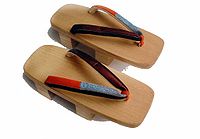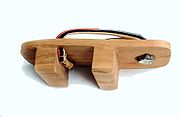
Geta (footwear)
Encyclopedia

Sandal (footwear)
Sandals are an open type of outdoor footwear, consisting of a sole held to the wearer's foot by straps passing over the instep and, sometimes, around the ankle...
with an elevated wooden base held onto the foot with a fabric thong to keep the foot well above the ground. They are worn with traditional Japanese clothing such as kimono
Kimono
The is a Japanese traditional garment worn by men, women and children. The word "kimono", which literally means a "thing to wear" , has come to denote these full-length robes...
or yukata
Yukata
A is a Japanese garment, a casual summer kimono usually made of cotton. People wearing yukata are a common sight in Japan at fireworks displays, bon-odori festivals, and other summer events. The yukata is also frequently worn after bathing at traditional Japanese inns...
, but (in Japan) also with Western clothing during the summer months. Sometimes geta are worn in rain or snow to keep the feet dry, due to their extra height and impermeability compared to other shoes footwear such as zōri
Zori
are flat and thonged Japanese sandals made of rice straw or other plant fibers, cloth, lacquered wood, leather, rubber, or—increasingly—synthetic materials...
.
Styles
There are several different styles of geta. The most familiar style in the West consists of an unfinished wooden board called a dai (台, stand) that the foot is set upon, with a cloth thong (鼻緒, hanao) that passes between the big toe and second toe. As geta are usually worn only with yukataYukata
A is a Japanese garment, a casual summer kimono usually made of cotton. People wearing yukata are a common sight in Japan at fireworks displays, bon-odori festivals, and other summer events. The yukata is also frequently worn after bathing at traditional Japanese inns...
or other informal Japanese clothes or Western clothes, there is no need to wear socks. Ordinary people wear at least slightly more formal zori
Zori
are flat and thonged Japanese sandals made of rice straw or other plant fibers, cloth, lacquered wood, leather, rubber, or—increasingly—synthetic materials...
when wearing special toe socks
Toe socks
Toe socks are socks that have been knitted so that each toe is individually encased the same way as fingers within a glove....
called tabi
Tabi
are traditional Japanese socks. Ankle-high and with a separation between the big toe and other toes, they are worn by both men and women with zori, geta, and other traditional thonged footwear. Tabi are also essential with traditional clothing—kimono and other wafuku as well as being worn by...
. Apprentice geisha
Geisha
, Geiko or Geigi are traditional, female Japanese entertainers whose skills include performing various Japanese arts such as classical music and dance.-Terms:...
, also called "maiko", wear their special geta (see below) with tabi to accommodate the hanao.

Paulownia
Paulownia is a genus of from 6 to 17 species of plants in the monogeneric family Paulowniaceae, related to and sometimes included in the Scrophulariaceae. They are native to much of China, south to northern Laos and Vietnam, and long cultivated elsewhere in eastern Asia, notably in Japan and Korea...
) and make a distinctive "clacking" sound while walking: カランコロン or karankoron. This is sometimes mentioned as one of the sounds that older Japanese miss most in modern life. A traditional saying in Japanese translates as "You don't know until you have worn geta." This means roughly, "you can't tell the results until the game is over."
Long before the 1970s and before platform shoes, Japanese women wore Geta sandals or clogs.
The reason for wearing these very high platform shoes were not for fashion, but for very practical reasons. If you are wearing a very expensive kimono that hangs all the way to your feet, you do not want to get mud on it when you walk outside. Geta are made of one piece of solid wood forming the sole and two wooden blocks underneath. These blocks may have a metal plate on the section that touches the ground in order to lengthen the life span of the Geta. A V-shaped thong of cloth forms the upper part of the sandal.
Construction
The dai may vary in shape: oval ("more feminine") to rectangular ("more masculine") and color (natural, lacquered, or stained). The ha may also vary in style; for example, tenguTengu
are a class of supernatural creatures found in Japanese folklore, art, theater, and literature. They are one of the best known yōkai and are sometimes worshipped as Shinto kami...
-geta have only a single centered "tooth". There are also less common geta with three teeth. Merchants use(d) very high geta (two long teeth) to keep the feet well above the seafood scraps on the floor. The teeth are usually not separate, instead, the geta is carved from one block of wood. The tengu tooth is, however, strengthened by a special attachment. The teeth of any geta may have harder wood drilled into the bottom to avoid splitting, and the soles of the teeth may have rubber soles glued onto them.
The hanao can be wide and padded, or narrow and hard, and it can be made with many sorts of fabric. Printed cotton with traditional Japanese motifs is popular, but there are also geta with vinyl and leather hanao. Inside the hanao is a cord (recently synthetic, but traditionally hemp
Hemp
Hemp is mostly used as a name for low tetrahydrocannabinol strains of the plant Cannabis sativa, of fiber and/or oilseed varieties. In modern times, hemp has been used for industrial purposes including paper, textiles, biodegradable plastics, construction, health food and fuel with modest...
) that is knotted in a special way to the three holes of the dai. In the wide hanao there is some padding as well. The hanao are replaceable. It sits between the two first toes because having the thong of rectangular geta anywhere but the middle would result in the inner back corners of the geta colliding when walking. Recently, as Western shoes have become more popular, more Western looking geta have been developed. They are more round in shape, may have an ergonomically shaped dai, a thick heel as in Western clogs, instead of separate teeth, and the thong at the side as in flip-flops. According to Japanese superstition
Superstition
Superstition is a belief in supernatural causality: that one event leads to the cause of another without any process in the physical world linking the two events....
, breaking the thong on one's geta is considered very unlucky.
Custom
Geisha
Maiko (geisha in training) wear distinctive tall geta called okoboOkobo
, also referred to as pokkuri, bokkuri, or koppori geta from the sound made when walking, are wooden sandals worn by maiko during their apprenticeship. Okobo are very tall and usually made from a block of willow wood. Usually, the wood has either no finish or a natural finish, but during the...
which are similar to the chopine
Chopine
A chopine is a type of women's platform shoe that was popular in the 15th, 16th and 17th centuries. Chopines were originally used as a patten, clog, or overshoe to protect the shoes and dress from mud and street soil....
s worn in Venice
Venice
Venice is a city in northern Italy which is renowned for the beauty of its setting, its architecture and its artworks. It is the capital of the Veneto region...
during the Renaissance
Renaissance
The Renaissance was a cultural movement that spanned roughly the 14th to the 17th century, beginning in Italy in the Late Middle Ages and later spreading to the rest of Europe. The term is also used more loosely to refer to the historical era, but since the changes of the Renaissance were not...
. Also very young girls wear "okobo", also called "pokkuri" and "koppori", that have a small bell inside a cavity in the thick "sole". These geta have no "teeth" but are formed of one piece of wood. The middle part is carved out from below and the front is sloped to accommodate for walking. Pokkuri are usually red in color and are not worn with yukata, but a very fancy kimono (such as at shichi-go-san
Shichi-Go-San
is a traditional rite of passage and festival day in Japan for three- and seven-year-old girls and three- and five-year-old boys, held annually on November 15...
festivals).
Sumo
Japanese professional sumoSumo
is a competitive full-contact sport where a wrestler attempts to force another wrestler out of a circular ring or to touch the ground with anything other than the soles of the feet. The sport originated in Japan, the only country where it is practiced professionally...
wrestlers in the lowest two divisions of Jonokuchi and Jonidan must wear geta with their yukata
Yukata
A is a Japanese garment, a casual summer kimono usually made of cotton. People wearing yukata are a common sight in Japan at fireworks displays, bon-odori festivals, and other summer events. The yukata is also frequently worn after bathing at traditional Japanese inns...
at all times. The clacking sound that geta make when walking are consequently something aspiring sumo stars wish to leave behind as soon as possible.
See also
- Jandal
- Jika-tabiJika-tabiis a type of outdoor footwear worn in Japan. It was invented in the 20th century.Also known as "tabi boots", they are modelled on tabi, traditional split-toe Japanese socks...
- TabiTabiare traditional Japanese socks. Ankle-high and with a separation between the big toe and other toes, they are worn by both men and women with zori, geta, and other traditional thonged footwear. Tabi are also essential with traditional clothing—kimono and other wafuku as well as being worn by...
- WarajiWarajiWaraji are sandals made from straw rope that in the past were the standard footwear of the common people in Japan. Waraji were also worn by the samurai class and foot soldiers during the feudal era of Japan.-Description:...
- ZōriZoriare flat and thonged Japanese sandals made of rice straw or other plant fibers, cloth, lacquered wood, leather, rubber, or—increasingly—synthetic materials...
- Patten (shoe)Patten (shoe)Pattens are protective overshoes worn in Europe from the Middle Ages until the early 20th century. Pattens were worn outdoors over a normal shoe, held in place by leather or cloth bands, with a wooden or later wood and metal sole...
External links
- JapaneseGeta.com — Includes a how-to on making geta
- Wafuku blog about geta Names and descriptions of all the types of Japanese geta, with photos.
- Japan Footwear Museum

